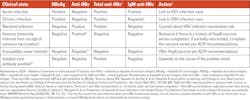Hepatitis B virus (HBV), despite widespread vaccination efforts, poses a global health challenge affecting around 2 billion people worldwide.1 Chronic HBV contributes to 30% of cirrhosis-related deaths and 40% of hepatocellular carcinoma-related deaths.4 The WHO recommends eradicating chronic viral hepatitis as a public health issue by 2030 through a 90% reduction of chronic HBV infection and a 65% decrease in associated mortality.3
HBV transmission occurs through percutaneous (skin-penetrating) or mucosal contact with infectious blood or body fluids, such as semen and saliva. Transmission can occur during pregnancy or delivery from an HBV-positive mother to her baby, through sexual contact with an infected partner, and via injection drug use that involves sharing needles, syringes, or drug-preparation equipment.6
In the United States, there are approximately 60,000 new cases of HBV diagnosed annually, contributing to an already substantial chronic HBV population of over 2 million. The severity of the disease is further underscored by the fact that it causes 5,000 deaths annually, emphasizing the critical need for comprehensive prevention and healthcare strategies to address this significant health challenge.5
Chronic HBV disproportionately impacts U.S. residents born outside the country. Despite comprising only 14% of the overall U.S. population, non-U.S.-born individuals represent 69% of those living with chronic HBV infection in the country.6
In 2019, following a decade of consistent rates, there was a sudden 32% decline in the incidence of acute hepatitis B in the U.S. This reduction could be linked to a decrease in healthcare-seeking behavior during the COVID-19 pandemic.6
Clinical features
While not everyone newly infected with HBV will exhibit symptoms, some will experience fatigue, poor appetite, stomach pain, nausea, and jaundice. HBV can present as a brief illness or transform into a chronic infection, posing the risk of severe, potentially life-threatening health complications including liver disease or liver cancer.6
Age is also a factor. Approximately 9 out of 10 infants infected with hepatitis B will experience lifelong, chronic infections, with the risk decreasing as the child grows older. In contrast, most children aged 6 and older recover fully without progressing to chronic infection.6
The progression of chronic HBV does not always follow a linear course. Individuals may transition from having high viral levels without liver disease activity to experiencing active liver disease and, subsequently, returning to a state of no liver activity with low viral levels. This poses a significant challenge in the management of HBV.7
Screening and diagnosis
Screening involves testing serum for the presence of HBsAg to identify chronic infection. A diagnosis of chronic HBV infection is established when HBsAg persists for six months. Additionally, screening should incorporate the antibody to hepatitis B surface antigen (Anti-HBs) to identify individuals who have not been exposed, enabling them to be offered HBV vaccination.3
The CDC's 2023 recommendations for HBV suggest screening adults aged ≥18 years at least once in their lifetime. It also recommends a triple panel test, which includes screening for HBsAg, anti-HBs, and total antibody to hepatitis B core antigen (total anti-HBc or HBcT). The triple panel test can also be employed for periodic risk-based testing. Another approach is to begin with the anti-HBc test and, if positive, follow up with HBsAg and anti-HBs testing.6 For infants, healthcare professionals should conduct testing for both HBsAg and anti-HBs seromarkers if they are born to individuals who are HBsAg-positive. Lastly, for pregnant individuals, medical practitioners should conduct HBsAg testing during each pregnancy, ideally in the first trimester. This is recommended irrespective of vaccination status or past testing history. Pregnant individuals who have undergone appropriately timed triple panel screening and have not been exposed to new risks for HBV since screening should be tested for HBsAg.6
The American Association for the Study of Liver Diseases (AASLD) guidelines recommend screening for:
- Individuals born in regions with high or intermediate HBV endemicity (where the prevalence of HBsAg is ≥2%)
- U.S.-born individuals not vaccinated during infancy with parents born in regions where HBV is highly endemic (≥8% prevalence)
- Pregnant women
- Individuals requiring immunosuppressive medications (including those undergoing chemotherapy), blood donors, and patients with end-stage renal disease.3
The World Health Organization (WHO) suggests:
- Widespread screening in countries where the seroprevalence of HBsAg is ≥ 2%
- Routine testing for all pregnant women attending antenatal clinics
- Regular screening of high-risk populations (such as sexual and household contacts of individuals with chronic HBV infection, those with HIV, injection drug users, men who have sex with men, sex workers, indigenous peoples, incarcerated individuals, and transgender persons)
- HBsAg screening of blood and organ donors
- HBsAg screening of adults showing signs and symptoms indicative of viral infection3
Laboratory findings and interpretation of screening tests
When assessing a patient with suspected hepatitis, besides conducting a comprehensive history and physical examination, laboratory tests should encompass a complete blood cell count and a complete metabolic panel. The metabolic panel should include ALT, AST, total bilirubin, alkaline phosphatase, albumin, creatinine levels, and INR assessments. Additionally, it is crucial to include markers indicating HBV replication, such as IgM antibodies against hepatitis B core (anti-HBc IgM), HBeAg, antibodies against hepatitis B e antigen (anti-HBe), and quantitation of HBV DNA.1
Furthermore, it is essential to obtain markers for potential coinfection with hepatitis C virus (HCV), hepatitis D virus (HDV), and human immunodeficiency virus (HIV) and assess immunity against HAV to determine the necessity for vaccination. The first identifiable viral marker is HBsAg, appearing in the serum 2 to 8 weeks before any elevation of aminotransferases. During the acute phase of infection, ALT and AST levels can surge to levels ranging between 500 and 5000 U/L, subsequently decreasing. Bilirubin levels in the serum seldom increase by more than 10 mg/dL; prothrombin times usually remain normal or exhibit mild elevation, and serum albumin levels are either normal or minimally depressed. Peripheral blood counts may indicate mild leukopenia, with or without relative lymphocytosis.1
Table 1 outlines the three primary serologic markers employed for determining HBV infection status: hepatitis B surface antigen (HBsAg), antibody to hepatitis B surface antigen (anti-HBs), and antibody to hepatitis B core antigen (anti-HBc).8
After identifying HBV infection, testing for other markers (HBeAg, anti-HBe, and HBV DNA) can offer insight into the degree of viral replication and infectivity, aiding clinical management:8
• HBV DNA measures viral load
• HBeAg denotes viral replication and heightened infectivity
• Anti-HBe can monitor response to treatment and progression of chronic HBV infection
Treatment
Antiviral therapy is intended to reduce HBV DNA to undetectable levels. This is linked to improvements in liver inflammation and fibrosis, the reversal of cirrhosis, a decreased risk of HCC (hepatocellular carcinoma), and lower liver-related mortality. However, it's important to note that none of the existing therapies offer a cure, and once treatment commences, it typically needs to be maintained for the foreseeable future.6
Eight approved drugs for treating chronic hepatitis B are currently available. These can be broadly classified into:
- Interferon preparations (standard interferon alfa-2b, peginterferon alfa 2a [peg-alfa 2a])
- Nucleos(t)ide analogs (lamivudine, adefovir, entecavir, telbivudine, tenofovir disoproxil fumarate, and tenofovir alafenamide)
Both WHO and AASLD guidelines recommend entecavir (for children ≥2) and tenofovir (for children ≥12) as first-line therapies for chronic HBV infection. AASLD also includes tenofovir alafenamide, an orally available prodrug of tenofovir with similar antiviral efficacy but lower renal and bone toxicity.
Antiviral treatment is typically unnecessary for uncomplicated symptomatic acute HBV, as about 95% of immunocompetent adults experience spontaneous recovery. Therefore, the use of antivirals should be exercised with caution.1
References
- Dekker SE, Green EW, Ahn J. Treatment and Prevention of Acute Hepatitis B Virus. Clin Liver Dis. 2021;25(4):711-724. doi:10.1016/j.cld.2021.06.002.
- Schweitzer A, Horn J, Mikolajczyk RT, Krause G, Ott JJ. Estimations of worldwide prevalence of chronic hepatitis B virus infection: a systematic review of data published between 1965 and 2013. Lancet. 2015;17;386(10003):1546-55. doi:10.1016/S0140-6736(15)61412-X.
- Vittal A, Ghany MG. WHO Guidelines for Prevention, Care and Treatment of Individuals Infected with HBV: A US Perspective. Clin Liver Dis. 2019;23(3):417-432. doi:10.1016/j.cld.2019.04.008.
- Hepatitis B. Who.int. Accessed May 7, 2024. https://www.who.int/news-room/fact-sheets/detail/hepatitis-b.
- Tripathi N, Mousa OY. Hepatitis B. StatPearls Publishing; 2023.
- CDC. Hepatitis B. Centers for Disease Control and Prevention. Published August 29, 2023. Accessed May 7, 2024. https://www.cdc.gov/hepatitis/hbv/index.htm.
- McMahon BJ. Natural history of chronic hepatitis B. Clin Liver Dis. 2010;14(3):381-96. doi:10.1016/j.cld.2010.05.007.
- Conners EE, Panagiotakopoulos L, Hofmeister MG, et al. Screening and Testing for Hepatitis B Virus Infection: CDC Recommendations - United States, 2023. MMWR Recomm Rep. 2023;10;72(1):1-25. doi:10.15585/mmwr.rr7201a1.






